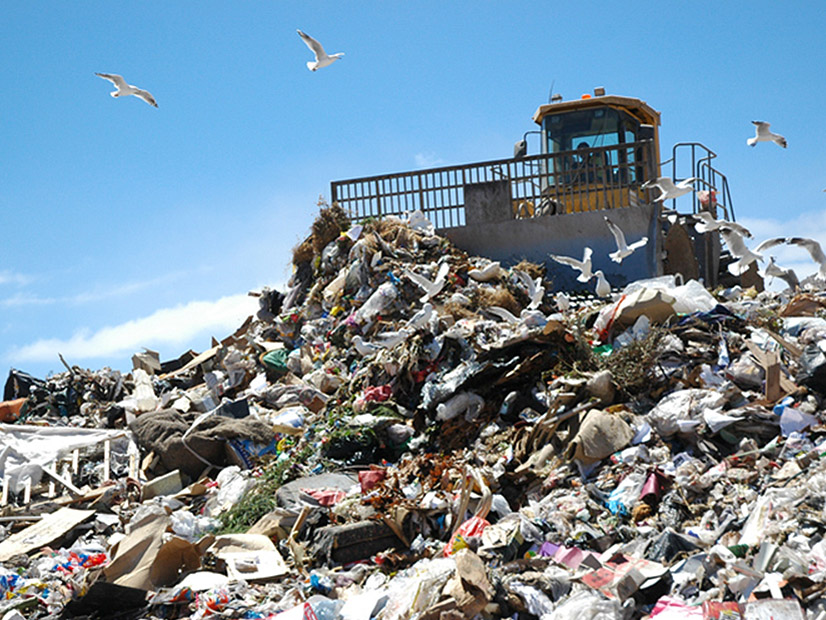Oregon’s Environmental Quality Commission (EQC) last week approved rules that will give the state the most stringent landfill gas emissions standards in the U.S., part of an effort to reduce the release of heat-trapping methane.
The state currently follows EPA standards for landfill gas emissions. The new rules proposed by its Department of Environmental Quality (DEQ) will exceed those standards by expanding the categories of landfills subject to gas emission regulations while lowering the size threshold for facilities covered, among other changes.
According to DEQ estimates, landfills accounted for 37% of Oregon’s carbon dioxide equivalent (CO2e) emissions from stationary sources in 2019, excluding electricity generators. Landfills represented six of the 25 largest sources of greenhouse gas emissions in that category, the agency found. Methane makes up about 40 to 60% of those emissions from landfills.
“If you look at just a 20-year time span, methane’s global warming potential is over 80 times that of carbon dioxide. This shows why landfill gas control is an important element in greenhouse gas emissions reductions,” Heather Kuoppamaki, DEQ senior environmental engineer, told the EQC on Friday.
The DEQ set out to revise Oregon’s landfill gas rules in response to Gov. Kate Brown’s Executive Order 20-04, which last year directed state agencies to use their existing regulatory authority to find ways to reduce the state’s GHG emissions.
In crafting the new rules, Kuoppamaki explained, Oregon looked to California’s regulations — the country’s strictest — as a template. The DEQ found some key differences between the two sets of rules, including the fact that Oregon’s existing rules cover only municipal solid waste landfills, while California’s also include industrial waste landfills. California’s rules also have a much lower threshold for the size of landfills covered: 496,000 tons of waste-in-place versus 2.5 million tons in Oregon.
Kuoppamaki noted also that California has “much tighter” surface emissions monitoring and gas destruction standards, requiring landfills to install gas collection and control systems if they emit methane at concentrations of at least 200 parts per million by volume (ppmv), compared with 500 ppmv for the Oregon/EPA standard. California also requires monitoring equipment to be placed on pathways spaced 25 feet apart, compared with 98 feet in Oregon.
Oregon’s new rules match California’s by adopting the 200-ppmv and 25-foot standards. The DEQ will also expand program coverage to encompass industrial landfills, including construction and demolition waste landfills, which are exempt from oversight under California regulations.
The DEQ’s new rules will additionally surpass California’s by reducing the covered landfill size threshold to more than 200,000 tons of waste-in-place. Landfills under that threshold will be “conditionally” exempt from the rules if they maintain an adequate landfill cover. They will also be required to maintain records verifying the amount of waste-in-place.
Landfills exceeding the 200,000-ton threshold that produce less than 664 metric tons (MT) of methane per year must obtain a “simple” air containment discharge permit (ACDP), requiring them to submit annual reports on the amount and type of waste received and provide updated landfill gas generation reports.
Active and closed landfills that emit at least 664 MT of methane per year must obtain a standard ACDP. “Landfill owners or operators in this category would be required to either conduct surface emission monitoring, or, if surface emission monitoring shows methane emissions greater than 200 ppmv, install and maintain a gas collection and control system, along with continued surface emission monitoring,” the DEQ said.
The DEQ estimates that 15 landfills that were not previously required to have ACDPs will be required to obtain the permits, on top of the 12 in the state that already hold one. Kuoppamaki said it’s “really hard to estimate” which landfills will be required to install collect-and-control systems. After being flagged, landfill owners will have 30 months to complete the systems.
“Most landfill owners are local governments, both city and county, or private businesses,” DEQ said.
New ACDP applications will be due Oct. 1, 2022.




